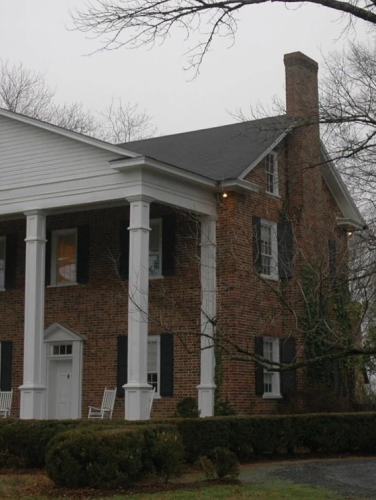
White Oak
(ca. 1792)
White Oak was the family home of a veteran of the Battle of Kings Mountain that prompted British forces to evacuate Mecklenburg County.
7645, 7729, 7810 Hood Rd, 7756 Hammond Dr, Charlotte, NC 28215
William Johnston (1741-1812), a prominent 18th-century Scotch-Irish resident of Mecklenburg County, served in the North Carolina militia during the American Revolutionary War. He fought as a captain in the October 1780 Battle of Kings Mountain. Prior to the war, in 1762, William married Mary Ann Parks (1742-1806) in Perquimans, North Carolina. After the war, the couple lived in Rowan County and Davidson, North Carolina.
Property Quick Links
In the 1790s, William purchased several large tracts of land in Mecklenburg County, including the 414-acre tract in the Reedy Creek community where he established the White Oak plantation. Local tradition holds that the house was built in about 1792, making it one of the earliest and finest Federal Style homes extant in Mecklenburg County. William and Mary Ann had nine children, including their eldest child Elizabeth (1766-1843) who married Hezekiah Alexander, Jr., son of one of the framers of North Carolina’s first Constitution and Bill of Rights. William relied on enslaved labor for his agricultural operations. The 1790 census indicates that he owned two enslaved persons; by 1810, at least nine enslaved persons labored at White Oak. His 1806 will named only two enslaved persons, a woman named Sally and a man named Lee, whom William bequeathed to his sons Samuel (1783-1829) and Robert (b. 1786) respectively.
William died in 1812 and was interred at Sugaw Creek Presbyterian Church. White Oak stayed in the Johnston family until the 1840s, first by bequest from William to son Robert. From Robert the property passed to Robert’s brother Samuel, and then to brother, William Johnston, Jr. (1774-1847) who became a prosperous farmer. It is unclear how many children William Jr. may have fathered. By one account, nine sons and four daughters resulted from a relationship he had before marrying Mary Black in 1807. The marriage of William Jr. and Mary reportedly yielded another seven sons and two daughters. William Jr.’s 1846 will left much of his landholdings to his son Ezekial (1810-1874), but White Oak and 110.5 acres of land went to his daughter Malissa (1819-1853) and her husband William C. Morris.
Census records indicate that William Morris’ farm was typical of antebellum Mecklenburg County farms. Morris’ enslaved labor force – numbering twelve persons as of 1850 – could not compete with the few large-scale cotton plantations in the county. As a result, his farming operations focused primarily on corn, with some production of wheat, butter, and livestock. By 1870 Morris farmed 300 of his overall 900 acres of land, producing 100 bushels of corn, 120 bushels of wheat, fifty bushels of oats, and 275 pounds of butter. He died intestate around 1873, and his property was divided among his three children. Mary Jane Morris Cross, the eldest of the three, received the plot containing White Oak. The house remained in the Cross family until 1947. White Oak has since changed hands several times.

